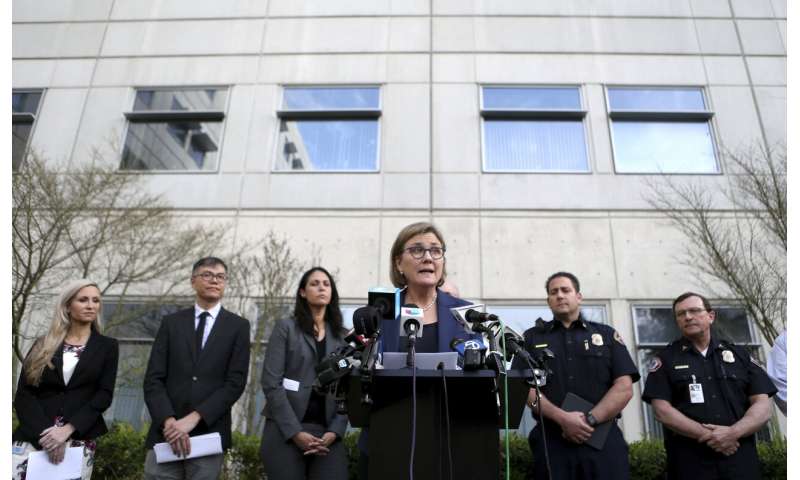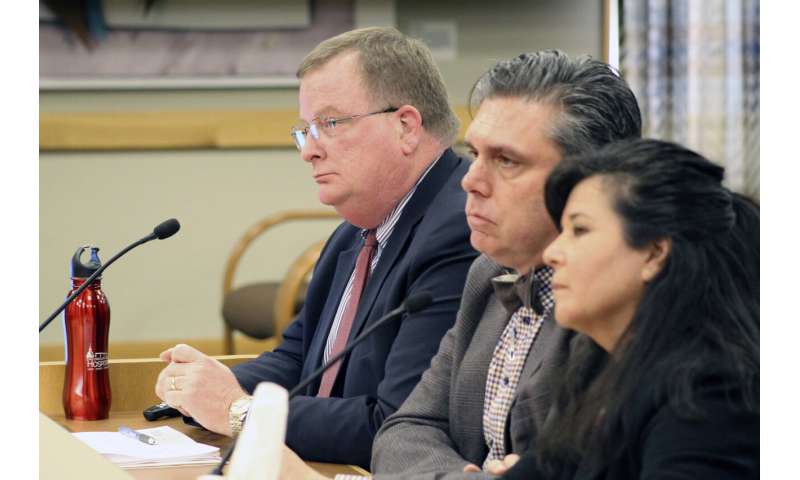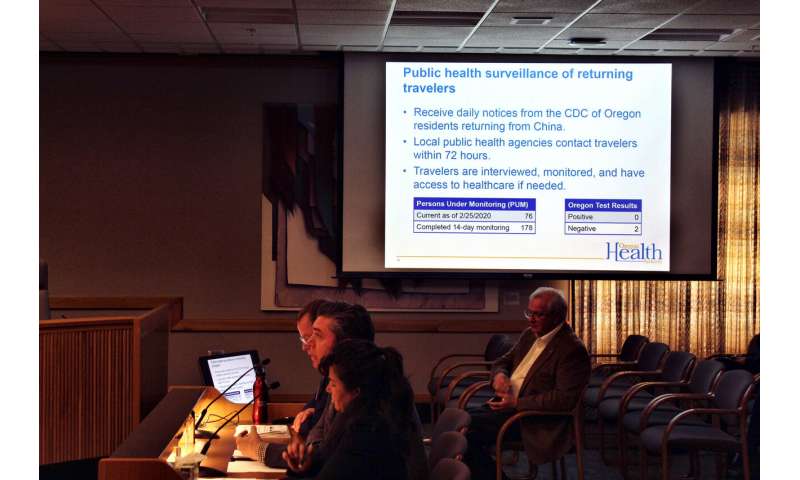
A man has died in Washington state of COVID-19, state health officials said Saturday, marking the first such reported death in the United States.
State officials issued a terse news release announcing the death, gave no details and scheduled a news conference. A spokesperson for EvergreenHealth Medical Center, Kayse Dahl, said the person died in the facility in the Seattle suburb of Kirkland, but gave no other details.
State and King County health officials said “new people (have been) identified with the infection, one of whom died.” They did not say how many new cases there are.
Amy Reynolds of the Washington state health department said in a brief telephone interview: “We are dealing with an emergency evolving situation.”
Washington Gov. Jay Inslee said the person who died was a man from Washington state.
“It is a sad day in our state as we learn that a Washingtonian has died from COVID-19. Our hearts go out to his family and friends,” Inslee said. “We will continue to work toward a day where no one dies from this virus.
The number of coronavirus cases in the United States is considered small. Worldwide, the number of people sickened by the virus hovered Friday around 83,000, and there were more than 2,800 deaths, most of them in China.
Most infections result in mild symptoms, including coughing and fever, though some can become more serious and lead to pneumonia. Older people, especially those with chronic illnesses such as heart or lung disease, are especially vulnerable. Health officials think it spreads mainly from droplets when an infected person coughs or sneezes, similar to how the flu spreads.

Health officials in California, Oregon and Washington state worried about the novel coronavirus spreading through West Coast communities after confirming three patients were infected by unknown means.
The patients—an older Northern California woman with chronic health conditions, a high school student in Everett, Washington, and an employee at a Portland, Oregon-area school—hadn’t recently traveled overseas or had any known close contact with a traveler or an infected person, authorities said.
Earlier U.S. cases include three people who were evacuated from the central China city of Wuhan, epicenter of the outbreak; 14 people who returned from China, or their spouses; and 42 American passengers on the Diamond Princess cruise ship, who were flown to U.S. military bases in California and Texas for quarantining.
Convinced that the number of cases will grow but determined to keep them from exploding, health agencies were ramping up efforts to identify patients.
The California Department of Public Health said Friday that the state will receive enough kits from the U.S. Centers for Disease Control to test up to 1,200 people a day for the COVID-19 virus—a day after Gov. Gavin Newsom complained to federal health officials that the state had already exhausted its initial 200 test kits.
Santa Clara County in the San Francisco Bay Area reported two cases where the source of infection wasn’t known. The older woman was hospitalized for a respiratory illness, and rapid local testing confirmed in one day that she had the virus, health officials said.
“This case represents some degree of community spread, some degree of circulation,” said Dr. Sara Cody, health officer for Santa Clara County and director of the County of Santa Clara Public Health Department.
“But we don’t know to what extent,” Cody said. “It could be a little, it could be a lot.”

“We need to begin taking important additional measures to at least slow it down as much as possible,” she said.
Cody said the newly confirmed case in Santa Clara County is not linked to two previous cases in that county, nor to others in the state.
The Santa Clara County resident was treated at a local hospital and is not known to have traveled to Solano County, where another woman was identified Wednesday as having contracted the virus from an unknown source.
Dozens of people had close contact with the Solano County woman. They were urged to quarantine themselves at home, while a few who showed symptoms of illness were in isolation, officials said.
At UC Davis Medical Center at least 124 registered nurses and other health care workers were sent home for “self-quarantine” after the Solano County woman with the virus was admitted, National Nurses United, a nationwide union representing RNs, said Friday.
The case “highlights the vulnerability of the nation’s hospitals to this virus,” the union said.
Earlier Friday, Oregon confirmed its first coronavirus case, a person who works at an elementary school in the Portland area, which will be temporarily closed.
The Lake Oswego School District sent a robocall to parents saying that Forest Hills Elementary will be closed until Wednesday so it can be deep-cleaned by maintenance workers.

Washington state health officials announced two new coronavirus cases Friday night, including a high school student who attends Jackson High School in Everett, said Dr. Chris Spitters of the Snohomish County Health District.
The other case in Washington was a woman in in King County in her 50s who had recently traveled to South Korea, authorities said.
Both patients weren’t seriously ill.
But health officials aren’t taking any chances. Some communities, including San Francisco, already have declared local emergencies in case they need to obtain government funding.
In Southern California’s Orange County, the city of Costa Mesa went to court to prevent state and federal health officials from transferring dozens of people exposed to the virus aboard a cruise ship in Japan to a state-owned facility in the city. The passengers, including some who tested positive for the virus and underwent hospital care, had been staying at Travis Air Force Base in Northern California.
On Friday, state officials said the federal decided it no longer had a crucial need to move those people to the Fairview Developmental Center in Costa Mesa. That’s because of the imminent end of the isolation period for those passengers and the relatively small number of persons who ended up testing positive, officials said.
The new coronavirus cases of unknown origin marks an escalation of the worldwide outbreak in the U.S. because it means the virus could spread beyond the reach of preventative measures like quarantines, though state health officials said that was inevitable and that the risk of widespread transmission remains low.
Federal officials think the coronavirus is spread only through “close contact, being within 6 feet of somebody for what they’re calling a prolonged period of time,” said Dr. James Watt, interim state epidemiologist at the California Department of Public Health.
Source: Read Full Article



